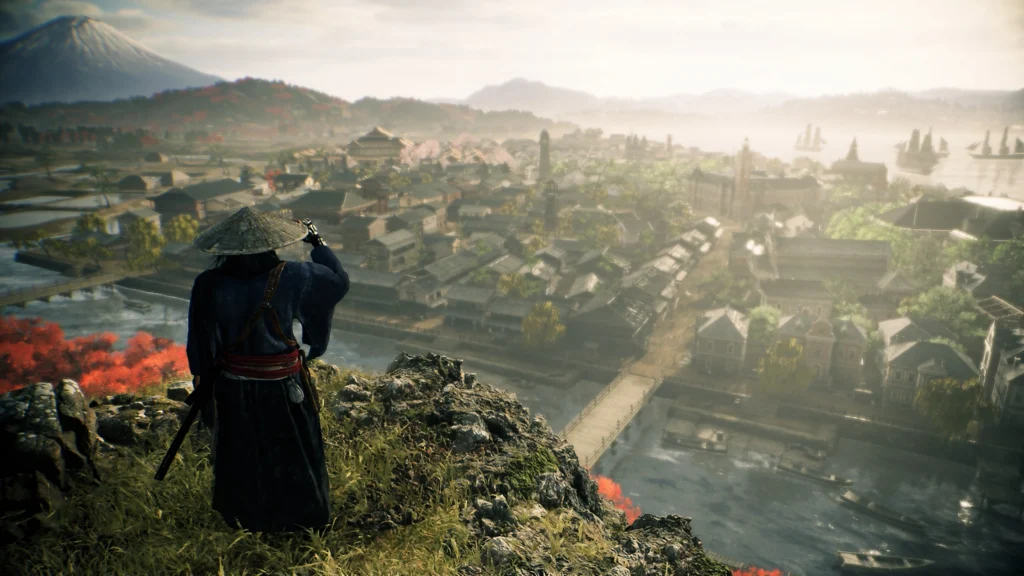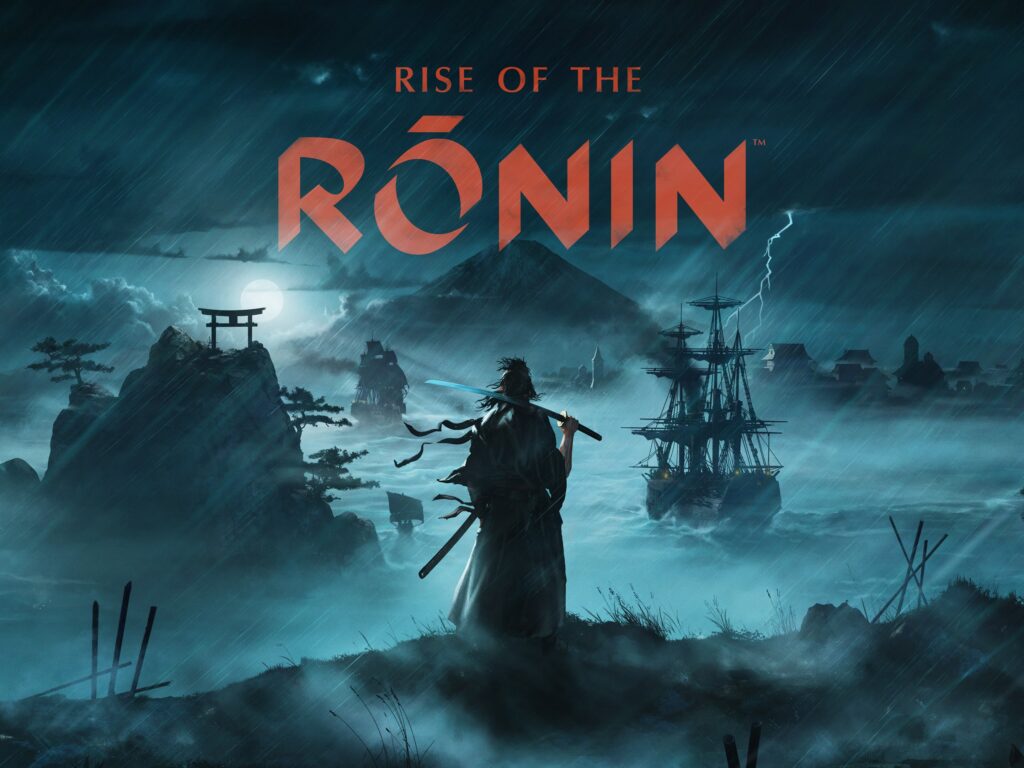“I will search for you through 1,000 worlds and 10,000 lifetimes until I find you.” These famous words were once spoken by Keanu Reeves in the 2013 hit movie 47 Ronin. Were these words meant to be received for love, or was the true meaning behind them, searching for the perfect Samurai-inspired video game?
Over the years, we have been treated with some great games that match this description. Two that jump to the front of the queue when mentioning Samurai-inspired games would definitely be 2019 hit Sekiro: Shadows Die Twice, and one of my favourite games, Ghost of Tsushima, which was released in 2020. Now we have a new one to add to the growing list, Rise of The Ronin. Brought to us by the stealthy assassins themselves, Team Ninja, who also brought us Nioh and Nioh 2. This, however, marks Team Ninja’s first attempt at an open-world game.
So how does this PlayStation 5 exclusive action role-playing game in Rise of The Ronin stack up against the others? And will it be deserving of a Hatamoto ranking?

Set in the Edo period in the mid-19th century of ancient Japan during the final years of the Bakumatsu, Rise of The Ronin kicks off with a couple of kickass Hollywood blockbuster cutscenes that introduces the game and give you an insight into the Veiled Edge. Two pairs of Samurai warriors trained to become one unit under the tutelage of a teacher known as the Blacksmith. Following the introduction, you are given the opportunity to create the main protagonist of the game. This option is something the other games don’t tend to have, and I, for one, am happy to see it. Here, you can select either a male or female character along with facial features, height, body mass, skin tones, tattoos, etc. I found myself spending too much time designing my character, which, in the end, I don’t think I was 100% on and could have done better with all the options available at hand. You will also need to choose your blade sharpening origin to determine the Veiled Edge’s initial abilities and special skills.
Not only do you have to design your main character, but you will also need to design a second one, which will be your Blade Twin. After playing through the first mission, where you get to fight the historical Western figure Commodore Matthew C. Perry, you decide which one of your characters you will play for the rest of the game. You can also shape the outcome of the main character’s story and fate based on the factions you choose to support throughout the 50-80 hour gameplay, which offers a deeply immersive experience with intertwining choices in this open-world setting. After selecting your character, you are now a lone samurai with no clan, a blade for hire – a Ronin!
This is far from an easy game in terms of combat. Rise of The Ronin falls under the Soulslike subgenre of games. If you are unfamiliar with these types of games, they are known for their high level of difficulty, which is designed to push players to their limits. Ruthless combat where you will die countless times while having limited time or resources to heal yourself. They also emphasize dark environmental storytelling, and Rise of The Ronin is no different. But saying all this, the game does offer three modes of difficulty upon the start, which can be changed anytime during your playthrough. The modes consist of – Dawn, for those who just want to enjoy the story of the game without the notorious and frustration of the soulslike experience. The second option is Dusk, for those who want some challenge but without pulling your hair out and throwing your controller across the room. The third and final mode is called Twilight, which brings all the pain and insanity of the soulslike experience. If you’re up for the challenge and don’t mind the neverending story of death, this mode will suit you to a tee. I myself went with the middle option in Dusk and while I did find it hard in places, the combat of this game feels very satisfying when it’s pulled off correctly.
RELATED: Rise of the Ronin Is Out Now
Rise of the Ronin’s combat is fun and brutal at the same time. Like the other two games I mentioned, they all have a parry move system and once mastered, it’s a very rewarding feeling for the players themselves and also an effective move in a counterattack. While Ghost of Tsushima’s combat was very easy to pick up and master, I would personally compare Rise of the Ronin to Sekiro in terms of combat if I had to. Both games fall under the soulslike subgenre, even playing it on the Dusk mode had me thinking about switching to Dawn to get past certain areas. The combat is very fluid and smooth, with a parry window that is bigger in Rise of The Ronin compared to Sekiro, but if you miss it, then it’s also more punishing than Sekiro as it leaves you open to follow-up attacks. Overall comparing the three in terms of combat and leaving Ghost of Tsushima in the corner of the room on its own to play with 10+ age group Lego. Rise of The Ronin’s combat is more accessible due to having a larger weapon variety, and character builds, so you have a lot more tools in your arsenal to combat any situation.
Pulling off the right timed parry followed by an attack that leaves your opponent’s head rolling on the ground with blood squirting everywhere is a great satisfaction, due to the main fact that you know they are not getting back up from that. This game is soulslike-coded but also offers some alternative combat, with the ability to shoot guns, throw shurikens and use your grappler to grab and throw exploding barrels at enemies. If you want to make a more stealthy approach to combat, you can. However, on most occasions, you will be forced to fight head-on. While there are opportunities for an insta-kill by ‘assassination’, I still felt like the game was forcing me to fight more than sneak. Overall, I feel that Rise of The Ronin is a smash-up in gameplay between the previously mentioned Souls games with a splash of Assassin’s Creed. The game offers in most cases, a physical challenge while also offering some quick stealth kills with some good old fashion looting. (Hey, they won’t be needing it where they’re going!)
One nice little thing that the game adds, and it’s a lifesaver in my books, is checkpoints in the form of flags. Moving up to these little flag poles and activating them raises the flag, so if you die, these come in handy. They also offer you the ability to replenish health and items too.
While exploring the open world that Rise of The Ronin has to offer, you will often come across various Cats that you will need and maybe want to pet. Not a Cat person? Well, you’re out of luck here. While petting these will be a pleasure for some, it does offer a greater incentive to unlock additional items that can be purchased as well as forming a stronger bond with a female character, Usugomo Dayu, whom you will meet early in the game’s story. Though this is different, I couldn’t help but feel I have seen this before with the Foxes in Ghost of Tsushima.
If you’re one for visualisation in games that really showcase the PS5’s capabilities, then you won’t find it here. Rise of The Ronin doesn’t really hold up against Ghost of Tsushima, which would be the best-looking Samurai game available and one of the best-looking games overall. It does feel a little bit outdated in certain parts, but saying this, the world does feel alive with beautiful scenic landscapes, falling snow in war-torn villages, to bustling cities that are populated with geisha girls and locals. It just doesn’t have the wow factor some games have. It does give you the option to run the game in three different modes: Performance mode, Graphics mode, and Ray Tracing mode.
The game soundtrack is fantastic, it really adds the atmosphere and battles in nearly every aspect of the game. With games set in Japan with, of course, Japanese characters, you have those traditionalist gamers out there who don’t care for the English dub and want the more suited Japanese voice-overs. This game has both English and Japanese voice acting and though I played most of my time with the English dub, I did play a small section with the Japanese voiceover and English sub as I can’t speak or understand Japanese. Having done this, I am glad I did as I found it more suited compared to the alternative.
Now, if you’re getting stuck throughout missions, the game also offers co-op multiplayer. You can bring in friends to help assist you with those pain-in-the-butt areas you just can’t seem to complete on your own. This all can be done at the Longhouse via the cooperate option or at the start of key missions. This is fairly limited and similar to how Dark Souls works, which allows you to bring in a player to help out with a challenge or boss fight, but then the game sends them away the moment the challenge is overcome. A nice touch and great for the helping hand, but don’t go expecting too much, like a complete co-op game where you can hold hands throughout the entire game itself.
So did Rise of The Ronin earn the Hatamoto ranking, which is the highest rank of a Samurai? I don’t think so. Rise of The Ronin felt like a lot of games were put in a blender and mixed together. It does, however, have its own charisma and personality. Even though I mentioned at times it felt like I was playing Ghost of Tsushima, Sekiro and Assassin’s Creed, this game went in its own direction, and that is mainly due to the narrative that weaves historical events and figures into a fictional tale that can be changed through different choices, and Team Ninja needs to be commended on that.
RISE OF THE RONIN REVIEW
Rise of the Ronin is a game created from a concoction of our favourite Samurai-inspired games. While it can give you a sense of déjà vu during your playtime, the game ultimately carves its own path and follows its own direction in the soulslike genre. The game is held back graphically but is redeemed through its enjoyable story and gameplay.
PROS
- Narrative with the ability to influence the outcome
- Features historical events and characters
- Fast & intense gruesome combat
- Epic boss fights
- Soundtrack with both English and Japanese voice over
CONS
- Combat takes time to master
- Outdated visuals
- Stealthing could be better integrated
